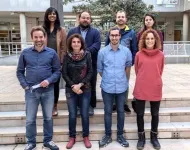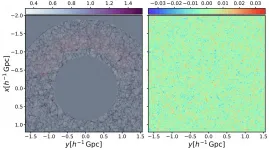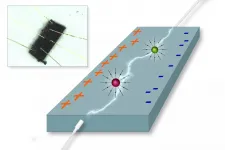The perfect recipe for efficient perovskite solar cells
2021-02-22
(Press-News.org) They have improved a process for vertically depositing a solution made from an inexpensive perovskite solute onto a moving substrate below. Not only have they discovered the crucial role played by one of the solvents used, but they have also taken a closer look at the aging and storage properties of the solution.
Solar cells made of crystalline silicon still account for the lion's share of roof installations and solar farms. But other technologies have long since become established as well - such as those that convert sunlight into electrical energy through use of extremely thin layers of solar-cell material deposited upon a substrate. The perovskite solar cells that Prof. Eva Unger and her team at the Helmholtz-Zentrum Berlin (HZB) are researching belong to this group. "These are the best solar cells to date that can be made using a 2D ink", the researcher explains. "And now their efficiencies are approaching those for cells made of crystalline silicon."
*Developing scalable methods*
Many methods have been developed and used to fabricate small test cells in the laboratory, where they can be studied and improved. But industrial-scale fabrication is still a long way off. Unger knows from her own experience: "Unfortunately, processes that are optimised for fabricating small surface areas cannot always be scaled up." In other words: Not everything that works perfectly in the lab also necessarily works economically on the factory floor. "That's why we are taking the next step and developing scalable methods. This means our team is focussing on processes for coating larger surfaces." At the Hybrid Silicon Perovskite Research, Integration & Novel Technologies (HySPRINT) Innovation Lab, an infrastructure for collaboration between HZB and industry, the team is concentrating on processes that have already proven their importance in industry to start with.
"We have experimented here with slot-die coating", she explains. In this process, the "ink", as the thin liquid solution of perovskite precursor, solvent, and additive is known in the trade, flows from a slit-shaped nozzle and falls like a curtain onto the glass substrate being conveyed below that will later become a solar cell. After application, crystallisation begins. An ultra-thin layer of a semiconducting perovskite structure grows that gives the material group its name and the solar cell its capabilities. Unger, together with her team members doctoral student Jinzhao Li and Dr. Janardan Dagar, have now discovered that the exact amount of an organic solvent called dimethyl sulfoxide (DMSO) in the material ink is critical for this process. Unger uses it as an additive because it has an amazing effect on the ink. "DMSO induces crystallisation nuclei for the perovskite", says the researcher. Crystallisation nuclei usually are tiny grains that help jump-start a crystal and promote its growth. "During X-ray diffraction experiments at BESSY II, we saw quite a big difference between inks with and without DMSO added", the physical chemist explains.
*It's the amount that counts*
However, as her team has found out in many experiments, the amount added plays a decisive role here. More DMSO favours crystal growth - up to a certain point. If this is exceeded, other processes come into play and the resulting microstructure reduces the performance of the solar cells. "It's like seasoning a soup", says Unger. "If you add too little, it remains bland. If you add too much, it won't taste good either. So you need to add just the right amount to make it best." In addition to the optimal composition, the HZB team has also thoroughly investigated the ageing processes and thus the storage life of the inks. "This is an aspect that has received little attention so far", Unger explains. "The age of a perovskite precursor ink can influence device performance. This is an important factor that must be considered when developing inks and processes."
INFORMATION:
[Attachments] See images for this press release:

ELSE PRESS RELEASES FROM THIS DATE:
2021-02-22
The regulation of satiety is an important factor that determines a higher or lower intake of energy and, therefore, has a considerable impact on the development and/or progression of obesity. The team made up of the researchers Lucia Camacho Barcia, Jesús García-Gavilán, Christopher Papandreou, and Mònica Bulló that leads the research group in Nutrition and Metabolic Diseases of the Department of Biochemistry and Biotechnology (Universitat Rovira i Virgili - Tarragona-Spain) have worked with researchers from Denmark ...
2021-02-22
Long-term sleep deprivation is detrimental to health, increasing the risk of psychiatric and somatic disorders, such as depression and cardiovascular diseases. And yet, little is known about the molecular biological mechanisms set in motion by sleep deprivation which underlie related adverse health effects.
In a recently published study, the University of Helsinki, the Finnish Institute for Health and Welfare, the Finnish Institute of Occupational Health and the Finnair airline investigated dynamic changes to DNA methylation in shift workers. DNA methylation denotes epigenetic regulation that modifies gene function and regulates gene activity without changing the sequence of bases in the DNA.
Short-term genetic changes caused by DNA methylation are not well known. While ...
2021-02-22
Physicists from Switzerland, Germany and Ukraine have proposed an innovative new data storage medium. The technique is based on specific properties of antiferromagnetic materials that had previously resisted experimental examination.
Using nanoscale quantum sensors, an international research team has succeeded in exploring certain previously uncharted physical properties of an antiferromagnetic material. Based on their results, the researchers developed a concept for a new storage medium published in the journal Nature Physics. The project was coordinated by researchers from the Department of Physics and the Swiss Nanoscience Institute at the University of Basel.
Antiferromagnets make up 90 percent of all magnetically ordered materials. Unlike ferromagnets such as iron, ...
2021-02-22
Using laws governing human rights may be the best way of harnessing international legislation and tribunals to protect the Amazon, a new study shows.
Safeguarding the rainforest is a critical priority because of the ecosystem's planetary importance. Recent increases in deforestation and fires in the region have made this even more urgent.
The new research, published in the Review of European, Comparative and International Environmental Law (RECIEL), says using human rights law to protect the Amazon is more likely to have stronger prospects, as campaigners wouldn't need to submit information about more than one nation for it to be upheld. Courts would only need to judge that environmental damage violated the rights of either certain individuals or tribal and indigenous peoples.
The ...
2021-02-22
The Instituto de Astrofísica de Canarias (IAC) has led an international team which has developed an algorithm called COSMIC BIRTH to analyse large scale cosmic structures. This new computation method will permit the analysis of the evolution of the structure of dark matter from the early universe until the formation of present day galaxies. This work was recently published in the journal Monthly Notices of the Royal Astronomical Society (MNRAS).
The IAC researcher, a co-author of the article and leader of the group of Cosmology and Large Scale Structure (LSS) Francisco-Shu Kitaura explains that one of the key aspects of this algorithm "consists in expressing the observations as if they had been detected in the early universe, which ...
2021-02-22
Moralities of Intelligent Machines is a project that investigates people's attitudes towards moral choices made by artificial intelligence. In the latest study completed under the project, study participants read short narratives where either a robot, a somewhat humanoid robot known as iRobot, a robot with a strong humanoid appearance called iClooney or a human being encounters a moral problem along the lines of the trolley dilemma, making a specific decision. The participants were also shown images of these agents, after which they assessed the morality of their decisions. The study was funded by the Jane and Aatos Erkko Foundation and the Academy of Finland.
The trolley dilemma is a problem ...
2021-02-22
Electric current is deflected by a magnetic field - in conducting materials this leads to the so-called Hall effect. This effect is often used to measure magnetic fields. A surprising discovery has now been made at TU Wien, in collaboration with scientists from the Paul Scherrer Institute (Switzerland), McMater University (Canada), and Rice University (USA): an exotic metal made of cerium, bismuth and palladium was examined and a giant Hall effect was found to be produced by the material, in the total absence of any magnetic field. The reason for this unexpected result lies in the unusual properties of the electrons: They behave as if magnetic ...
2021-02-22
The pituitary gland is a pea-sized endocrine gland composed of two structurally and functionally separate parts known as anterior and posterior lobes. The pituitary gland's anterior lobe secretes six hormones essential to growth, reproduction, and other basic physiological functions. Abnormal development of the pituitary gland, or hypopituitarism, can cause mild or complete deficiency of one or more pituitary hormones, which manifests as highly varying symptoms. Tumours mainly cause hypopituitarism in humans, but a congenital factor can also be associated with the disorder.
The POU1F1 gene regulates the development of the ...
2021-02-22
In Sweden, approximately one in five adults suffers from dental anxiety or phobia. The number has decreased over time, but still an important part of the population have major problems, according to a recent doctoral thesis from the University of Gothenburg.
The thesis includes a nationwide interview study involving 3,500 adult individuals, randomly selected from the general population of Sweden. Nineteen percent of the participants reported some degree of dental anxiety, fear or phobia.
The results showed that 4.7% of the respondents described their dental anxiety as severe, 4.5% as moderate and 9.8% as low. The remaining 80.9% reported no dental anxiety. The proportion with no dental ...
2021-02-22
Scientists of the P. N. Lebedev Physical Institute of the Russian Academy of Sciences (LPI RAS), the Moscow Institute of Physics and Technology (MIPT) and the Institute for Nuclear Research of RAS (INR RAS) studied the arrival directions of astrophysical neutrinos with energies more than a trillion electronvolts (TeV) and came to an unexpected conclusion: all of them are born near black holes in the centers of distant active galaxies powerful radio sources. Previously, only neutrinos with the highest energies were assumed to be obtained in sources of this class.
It is believed that there are massive black holes in the centers ...
LAST 30 PRESS RELEASES:
[Press-News.org] The perfect recipe for efficient perovskite solar cells






